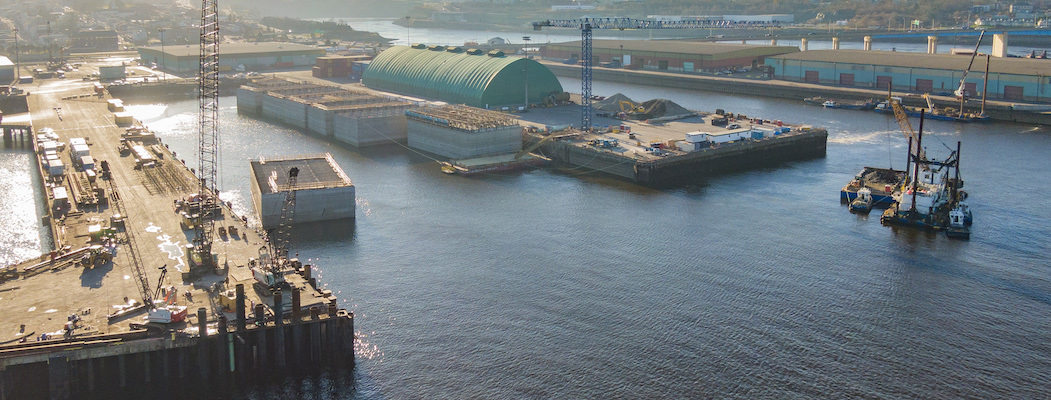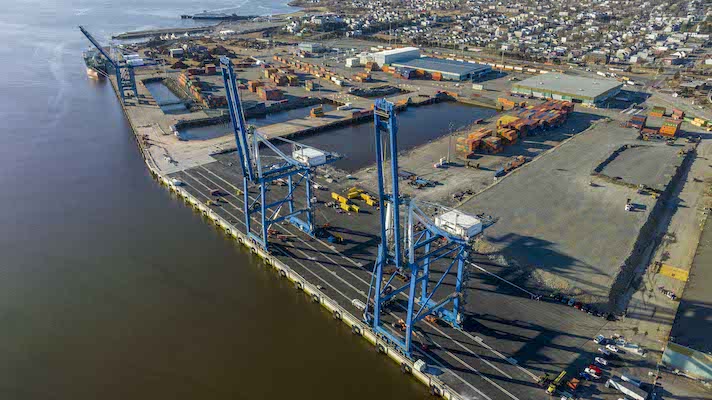
2023 #CCEAwards Showcase: Port Saint John Westside Modernization
November 3, 2023
By CCE
“The engineers’ ideas were key in facilitating the terminal’s growth.” – Jury
Category: Transportation
Award of Excellence Winners: Hatch and Dillon Consulting
Port Saint John proactively undertook the Westside modernization project to expand its container terminal and intermodal capacity. The port engaged Hatch and Dillon to develop scalable infrastructure while maintaining port operations in some of the highest tides in the world.
The objectives of the project were to both modernize the container terminal and increase its capacity to 650,000 20-foot equivalent units (TEUs). A second berth was built to accommodate bigger and deeper vessels. The intermodal yard, truck gate and container terminal were upgraded to facilitate growth for the entire operation. Project-specific innovations included extra-tall and environmentally appropriate caissons, a scalable rail yard and accommodating a crane track.
The project was built to meet the needs of the container terminal’s operator, DP World. All major design decisions required significant collaboration with DP World to ensure they would meet operational requirements while building capacity to accommodate future growth.
Hatch and Dillon’s technical expertise and mindfulness for social impacts drove the project and its successes, including lasting positive impacts on New Brunswick’s economy. In fact, Port Saint John has become North America’s fastest-growing container terminal.
A unique port project
Westside’s modernization was unique among port projects because of the size and complexity of building caissons on the site. It required major technical innovations, including the following:
- The design and construction of eight 27-m high concrete caissons—believed to be the tallest backfilled caissons in North America—to create a second container vessel berth for the facility.
- The design of a combination wall reinforcement for the existing wharf, to allow for dredging for the caisson mattress adjacent the existing piled structure.
- The design of a piled wharf to connect the new berth’s caissons to the existing berth.
- The design and management of multiple dredging contracts to ensure a deeper and more accessible main channel, as well as preparing the foundations for the caissons.
Hatch and Dillon considered the long-term outlook for the project and designed adaptable infrastructure, including a new 9,000-ft long intermodal railyard, which is scalable to meet future growth, with track spacing chosen to accommodate reachstackers and to transition to rubber-tired gantries in the future. A modernized truck gate for the terminal, meanwhile, would be fully automated to facilitate improved throughput.
Another unique requirement was for two existing cranes operating on the Rodney Marginal berth to be able to travel onto the new berth, which necessitated curved track, due to alignment constraints. The new berth had to simultaneously accommodate new 100-ft and existing 50-foot gauge cranes; not a common requirement for modern container berths.
A tall order
The tides, which can exceed 8 m, presented major design and operational challenges for the construction of a container berth at Port Saint John that could accommodate post-Panamax-sized vessels. In response, Hatch and Dillon designed the 27-m high caissons.
Caissons of this size had never been constructed in Eastern Canada before. Due to their size, a temporary mattress was constructed adjacent to the pier, so the caissons could touch down at low tide during the slip-forming process. All eight caissons were completed in one construction season and stored within the port’s slip until the mattress was ready to facilitate their placement.

The caissons were stored within the port’s slip until a temporary mattress was ready to facilitate their placement. Photo courtesy Hatch.
The harbour bottom had significant underlying soft soil and clay that needed to be dredged for the placement of a rock mattress to support the gravity-based caissons. Hatch and Dillon saw this challenge of dredging 600,000 m3 of soft soils as an opportunity for the project to reuse the soils for land reclamation.
This proved a very cost-efficient and environmentally friendly means of increasing the size of the container terminal. The project was designed and tendered so the dredge soils could be placed in the slips behind the new wharf. This reuse of material created several acres of land, mitigated environmental disruption outside the project’s footprint and saved costs.
Regional benefits
The project required significant lead time, from 2012 to 2019, to conceptualize, secure funding, confirm feasibility and gain stakeholder buy-in. Hatch and Dillon, who were involved from the beginning, completed pre-feasibility studies, prepared an appropriate budget and divided the work into 16 smaller packages, which enabled more local participation and competition, thereby meeting the goal of completing the project quickly and on-budget.
Port Saint John secured provincial and federal investments for the project and undertook studies of its social and economic impacts and benefits to the surrounding region. When the project was 50% complete, both New Brunswick’s provincial government and the port realized economic growth was happening much more rapidly than expected.
In 2021, the government decided to get in front of this growth, to ensure the region was well-prepared for the finished project. By that point, the Port had already had to hire operators for new reachstackers and cranes. The province partnered with employers, labour representatives and others to maximize employment and economic development opportunities.
Hatch and Dillon also achieved social benefits by assisting in the project’s consultation efforts with local First Nations. This process involved engaging communities by outlining the development of capacity agreements in support of continued relationship-building between the port authority and the First Nations, both throughout project construction and beyond.
As the environmental permitting process began in 2018, Hatch and Dillon supported the port and other federal authorities by consulting with the Wolastoqey, Mi’kmaq and Peskotomuhkati Nations of New Brunswick. This process helped federal authorities meet their duties under the Environmental Effects Evaluation (EEE) and the Fisheries Act Authorization. Hatch and Dillon worked closely with Indigenous communities to identify and advance fish passage improvement opportunities, aimed at offsetting the residual effects of the project on fish and their habitats, as required by the Fisheries Act Authorization.
Finally, Hatch and Dillon worked with the Wolastoqey Nation in New Brunswick (WNNB) to collect baseline environmental data for offsetting opportunities and conducted follow-up and monitoring activities.
Port Saint John Westside Modernization, Saint John, N.B.
Award-winning firm (prime consultant): Hatch, Halifax, N.S. (Lorne Flowers, P.Eng.; Jeff Theriault, P.Eng.; Serge Doucet, P.Eng.; Fanus Van Biljon, P.Eng.).
Award-winning firm (construction manager): Dillon Consulting, Saint John, N.B. (Darcy Harris, P.Eng.; Joe Cormier, P.Eng.; Kevin Walsh; Denis Marquis).
Owner: Port Saint John.
